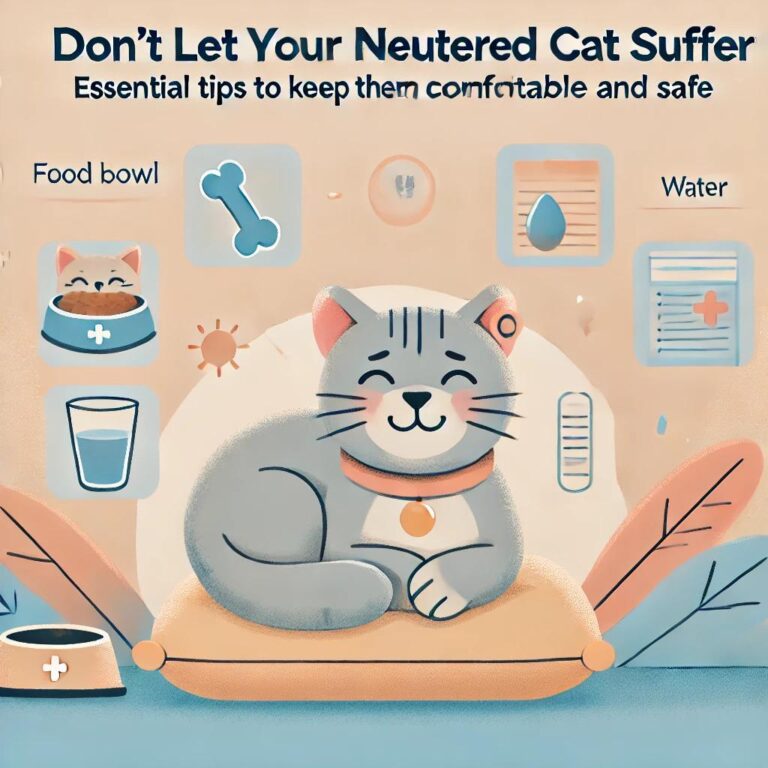
Bringing home your cat after surgery can be nerve-wracking. You take a long look at their tired little face, knowing you need to do everything you can to make them comfortable and safe. But where exactly do you start?
I remember the day I brought my cat, Whiskers, back from the vet. He looked at me with those big, soulful eyes, his little body wrapped in a bandage. He was groggy, disoriented, and slightly confused—no doubt wondering why his daily adventures had been interrupted by this strange ordeal. It was clear that to make Whiskers’ recovery comfortable, I needed to be fully prepared. Here’s what I learned and how you, too, can ensure your cat stays safe and comfy after surgery.
1. Create a Cozy, Quiet Recovery Space
Imagine coming home after surgery and being met with noise, bright lights, and bustling activity—stressful, right? Cats need a calm environment after being neutered. Choose a quiet corner of your home where they can rest undisturbed. When I set up Whiskers’ recovery area, I added a soft blanket and one of his favorite plush toys for comfort.

Tip: Use a soft, orthopedic cat bed (available on Chewy or Amazon) to give them a cozy spot that’s easy on their post-surgery body. Watching Whiskers curl up in his new bed, eyes half-closed with relief, was priceless.
2. Monitor for Any Post-Surgery Red Flags
It’s vital to keep an eye on the incision site and observe your cat’s behavior. Cats like Whiskers often act stoic even when they’re in discomfort, so it’s up to us to spot any signs of trouble. After Whiskers’ surgery, I checked his incision twice a day. The vet advised that slight redness was normal, but swelling or pus would mean trouble.

One day, I noticed Whiskers licking his stitches a bit too eagerly. This could lead to infection, so I quickly introduced him to the infamous “cone of shame,” or an E-collar. For cats who hate the traditional cone, softer alternatives like an inflatable collar (find them on Chewy or Amazon) can make a big difference in their comfort.
3. Keep Them Hydrated and Eating
The first day or two after surgery, Whiskers barely touched his food. This is common, but it’s crucial to encourage your cat to stay hydrated and eat, even if only a small amount. A little trick I used was to offer him warm, wet food (like Wellness CORE wet cat food). The warmth made it more aromatic, tempting him to take a few bites.

Cats that refuse to eat for more than 24 hours may need veterinary intervention. Remember, hydration is just as essential. A cat water fountain from Amazon can make drinking more enticing and even a little fun.
4. Avoid Excessive Activity
As soon as Whiskers started feeling a bit better, he tried to jump on the couch as if nothing had happened. Cats are masters at pretending they’re fine, even when they shouldn’t be active. I had to be proactive in preventing him from jumping or climbing. Placing temporary barriers or using cat playpens can help limit their movement.

Pro Tip: Interactive toys like catnip mice or puzzle feeders (available on Chewy) kept Whiskers entertained while ensuring he didn’t exert himself.
5. Keep the Incision Site Clean and Dry
One morning, Whiskers, in true feline fashion, decided to roll around in a corner of the living room that I hadn’t noticed was a bit dusty. Keeping the area clean and dry is critical to avoid infection, so I had to gently brush off any loose particles from his fur. Never bathe your cat until the vet gives the green light—moisture can be the enemy of healing.

6. Offer Extra Comfort with Calming Solutions
Surgery can make cats feel anxious or restless, and Whiskers was no exception. I noticed he would pace around and meow softly during the first few nights. To help, I used calming diffusers like Feliway, which release pheromones that mimic those a mother cat would emit. These products can work wonders and are available on Chewy y Amazon. Note though that everyday diffusers are a no-no for cats, as essential oils can be dangerous to them.

Seeing Whiskers finally settle down and curl up, purring softly, made me feel like I was doing my job as a cat parent.
Conclusión
Neutering is a routine procedure, but recovery can be stressful if you’re not prepared. By creating a cozy space, monitoring behavior, using the right products, and giving lots of love and patience, your cat’s recovery can be smooth and relatively stress-free.
After two weeks of care, Whiskers was back to his usual antics—playfully chasing invisible ghosts and pretending he was the king of the house. It’s a reminder that with the right preparation, you can help your cat recover comfortably and get back to being their silly, mischievous self in no time.




